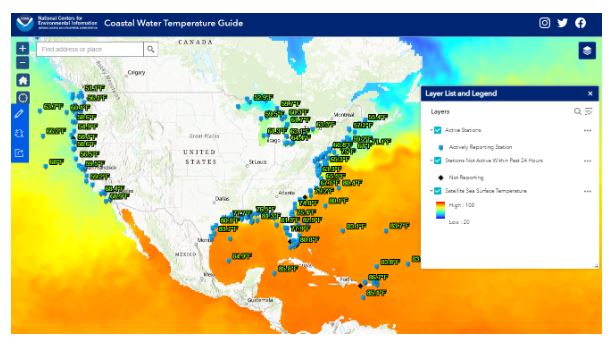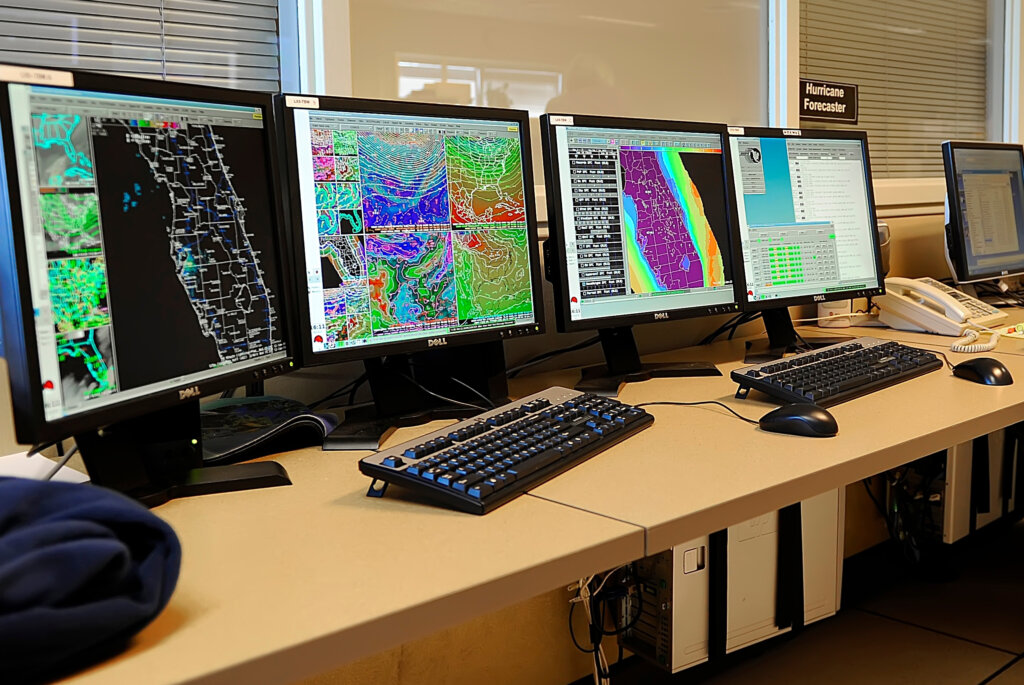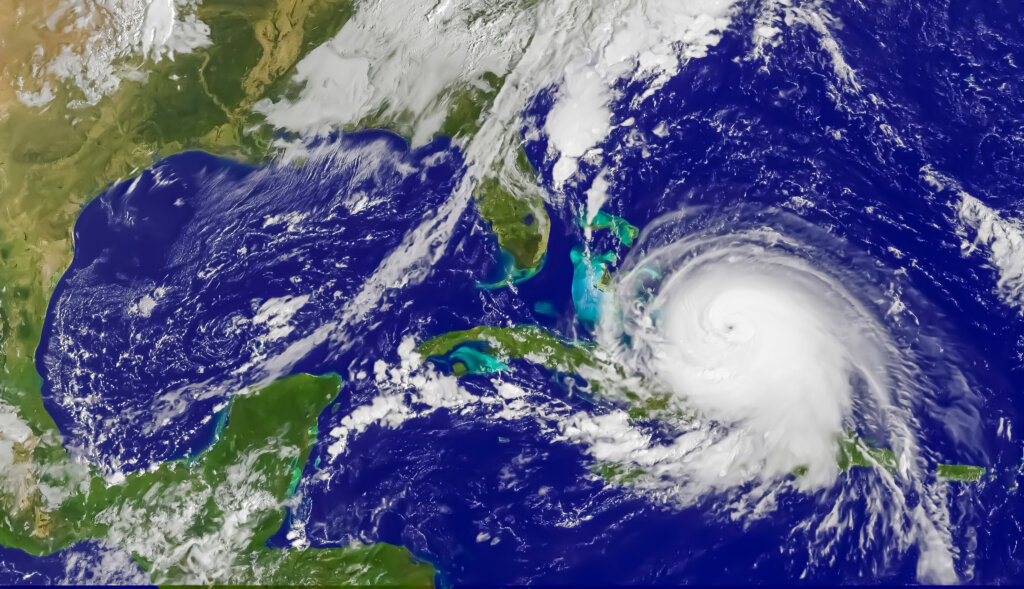Whether or not one subscribes to global warming and climate change theories, the fact remains that recent years of rising winter and summer temperatures have led to warmer ocean waters … which in turn fuels the intensity and frequency of violent storms and natural disasters. The Gulf of Mexico and the Atlantic Ocean off the coast of southwest Florida are approximately 89.6 F degrees (32 degrees C) as of this past week.1 These warmer waters provide the energy needed for hurricanes and typhoons to grow stronger, resulting in devastating impacts on coastal communities. Additionally, the increased frequency of such events strains emergency response systems and disrupts supply chains … highlighting the urgent need for innovative strategies in disaster preparedness and response.
Power resiliency is of utmost importance, both in preparation for and in the wake of hurricane landfalls, flooding, wind damage, and inland tornadoes. Given the imminent threat to the electrical power grid, how can businesses ensure that they remain agile while meeting ever-evolving customer needs associated with weather-related natural disaster preparation and recovery? The answer to this question lies in the adherence to and execution of an innovative 6-point strategy, which enables companies to remain lean and responsive to market demands:
- Observe The 7 – 10 Day Hurricane Forecast
- Leverage Data Analytics To Evaluate Product Availability & Demand
- Optimize Stock Levels
- Utilize Quick-Ship Warehouses
- Integrate Same-Day Order/Ship Capabilities
- Continuous Improvement & Adaptation

1. Observe The 7 – 10 Day Hurricane Forecast
Weather forecasting has become increasingly accurate due to advancements in technology, data collection, and computational power. Meteorologists utilize sophisticated satellite systems and radar technology to monitor atmospheric conditions in real-time. Data from electronic weather observation stations, buoys, and aircraft are fed into complex computer models that simulate weather patterns with high precision. Combined with machine learning algorithms, these models enable forecasters to predict weather events with greater accuracy, providing valuable information for planning and preparedness.

Annual hurricane season for the Atlantic basin and Gulf of Mexico is from June 1 – November 30, with peak developments and landfalls occurring between mid-August to mid-October.2 The 7-10 day hurricane outlook can be viewed daily on local and national television stations throughout North America, and provides a medium-range forecast that helps predict the potential development and trajectory of tropical storms and hurricanes. This proactive approach allows communities to prepare and respond effectively, minimizing the impact of hurricanes and enhancing overall safety and resilience.
2. Leverage Data Analytics To Evaluate Product Availability & Demand
Leveraging data analytics to evaluate product availability and demand helps businesses prepare for forecasted hurricane development and landfall by providing critical insights into inventory needs and consumer behavior. By analyzing historical sales data, current market trends, and inventory needs, companies can anticipate spikes in demand for essential items and emergency supplies. This proactive approach allows for timely stock adjustments, ensuring that warehouses are well-equipped to meet increased demand. Additionally, real-time data analytics enable businesses to monitor supply chain and logistics disruptions and make informed decisions to maintain product availability … ultimately enhancing their ability to support communities during and after a hurricane.
When it comes to electrical power resiliency and restoration, the local utility company can analyze the data from past outages and restoration times, reasonably predict which areas are most likely to be affected by the hurricane and storms, and prepare accordingly. The utility can pre-order the necessary reels of power cable and other electrical power distribution equipment required to restore electrical service as quickly as they are safely able. Real-time data analytics also facilitate efficient resource allocation and workforce deployment, ensuring that repair crews are dispatched promptly to the hardest-hit areas. Ultimately, this data-driven approach minimizes downtime, accelerates restoration efforts, and enhances the overall resilience of the power grid.
3. Optimize Stock Levels
By ensuring that essential products are available without overburdening storage capacities and by maintaining an optimal balance of inventory, businesses can quickly respond to sudden spikes in demand for critical supplies. Proactive inventory management with real-time tracking reduces the risk of emergency products and supplies being out-of-stock, and ensures that warehouses are not overwhelmed with excess inventory which is also costly and inefficient.
Optimized stock levels are vital for power resiliency and restoration, ensuring that utility companies have the necessary equipment and materials readily available to quickly respond to power outages. With access to a fully-stocked inventory of critical components such as cables, transformers, spider boxes, and other power distribution equipment, utilities can respond more efficiently to power grid restoration … thus minimizing downtime, accelerating the restoration of power, and reducing the impact on affected communities.

4. Utilize Quick-Ship Warehouses
Quick-Ship warehouses are a game-changer and are revolutionizing logistics. As a pivotal innovation in contemporary logistics, these warehouses are designed for speed. From order placement, through order fulfillment, and same-day delivery, rapid turnaround enhances customer satisfaction and consolidates operational efficiencies … a true win-win for customers and suppliers alike.

Available Stock Packaged And Ready To Ship
The impact of Quick-Ship warehouses is profound. Agile businesses can minimize lead times by leveraging cutting-edge technologies and strategically-located products. By integrating Quick-Ship facilities into their supply chains, companies can ensure same day order/ship services, exceeding customer expectations. Innovative stocking strategies, same-day order fulfillment, and same-day delivery underscore a relentless commitment to customer service.
Utilizing Quick-Ship warehouses is crucial for power resiliency and restoration as these facilities enable rapid deployment of essential equipment and materials to areas affected by hurricanes and violent weather. These strategically-located warehouses ensure that critical components such as electrical power cable and other power distribution products are readily accessible and available. Quick-Ship order fulfillment allows utility companies to swiftly mobilize resources, ensuring that repair crews have the necessary supplies to restore power efficiently. This agility not only minimizes downtime for affected communities but also enhances the overall resilience of the power grid, ensuring a faster and more effective recovery process.
5. Integrate Same-Day Order/Ship Capabilities
By integrating same-day order/ship capabilities, businesses can be readily prepared for any forecasted hurricane development and landfall … thus ensuring that essential supplies can be delivered rapidly to meet urgent demands. This capability allows companies to respond immediately to spikes in orders for critical items, and ensures that these vital products reach affected areas quickly … enhancing community preparedness and resilience. Additionally, this rapid response capability helps maintain customer trust and satisfaction during emergencies, positioning these businesses as a reliable and responsive partners in times of crisis.
Regarding electrical power resiliency and restoration, same-day order/ship capabilities ensure that essential repair products and equipment can be delivered immediately to areas impacted by hurricanes, floods, and other violent weather events. This rapid delivery system allows utility companies to quickly replenish their stocks of critical items such as transformers, cables, and repair tools, which are vital for restoring power. Utilities are then able to minimize the duration of power outages and expedite the restoration process, ensuring that affected communities regain full access to electrical power. Ultimately, same-day order/ship capabilities enhance the overall resilience of the power grid, allowing for a more efficient and effective response to natural disasters.

6. Continuous Improvement & Adaptation
Continuous improvement and adaptation are integral to staying ahead in dynamic market conditions. For companies to thrive, embracing innovative stocking strategies is essential. By continually reassessing and adapting inventory management practices, businesses can anticipate market changes and mitigate disruptions. This commitment to growth ensures that these companies remain agile and responsive to customer demands. This flexibility allows an organization to implement same-day order/ship processes, thereby maintaining competitive advantages provided by Quick-Ship warehouses.

Continuous improvement and adaptation help businesses prepare for forecasted hurricane development and landfall by fostering a culture of resilience and proactive planning. By regularly evaluating and refining their processes, businesses can identify vulnerabilities and implement strategies to mitigate risks associated with hurricanes and other severe weather events. This approach ensures that supply chains remain robust, inventory management practices are optimized, and emergency response plans are up-to-date. Such continuous improvement encourages the adoption of new technologies and best practices, enhancing companies’ ability to respond quickly and efficiently to changing conditions. Ultimately, this commitment ensures that businesses are better equipped to protect their operations and support their communities during and after hurricanes and extreme weather events.
Continuous improvement and adaptation are also crucial for electrical power resiliency and restoration as these processes enable utility companies to enhance their response strategies and infrastructure over time. By consistently evaluating past performance and incorporating lessons learned from previous hurricanes, utilities can identify weaknesses and implement more effective solutions. Therefore, power grids are fortified against future storms by having improved technologies and practices in place. Continuous adaptation allows for the integration of innovative tools and methodologies … including advanced data analytics and real-time monitoring systems, which enhance the efficiency and speed of restoration efforts. Ultimately, continuous improvement ensures a more resilient power grid, capable of withstanding and recovering from natural disasters more effectively.
Conclusion
Implementing innovative stocking and shipping strategies, leveraging data analytics, and optimizing inventory management with Quick-Ship capabilities are all essential for businesses to remain agile and responsive … especially in the face of hurricanes and other weather-related natural disasters. These practices not only ensure operational efficiency but also enhance community resilience and support during emergencies. Businesses are encouraged to continuously improve and to adapt forward-thinking approaches to strengthen their supply chains and disaster preparedness. These approaches enable companies to better serve their customers and contribute to a more resilient and responsive marketplace.
What about your business … as an end-user, are you and your team concerned about electrical power resiliency in the face of or in the wake of an extreme weather event? Or do you work with or for the local utility company, and want to know more about the Quick-Ship capabilities that provide same-day ordering and shipment of the power cable and distribution products needed for emergency electrical power restoration? Connect with our team of Application Solution Specialists to learn more about and consider the proactive benefits of Quick-Ship!
References:
1 National Centers for Environmental Information. Coastal Water Temperature Guide. https://coastalwatertemperatureguide-noaa.hub.arcgis.com/
2 National Oceanic and Atmospheric Administration. “Tropical Cyclone Climatology.” https://www.nhc.noaa.gov/climo/#:~:text=The%20official%20hurricane%20season%20for,%2DAugust%20and%20mid%2DOctober.